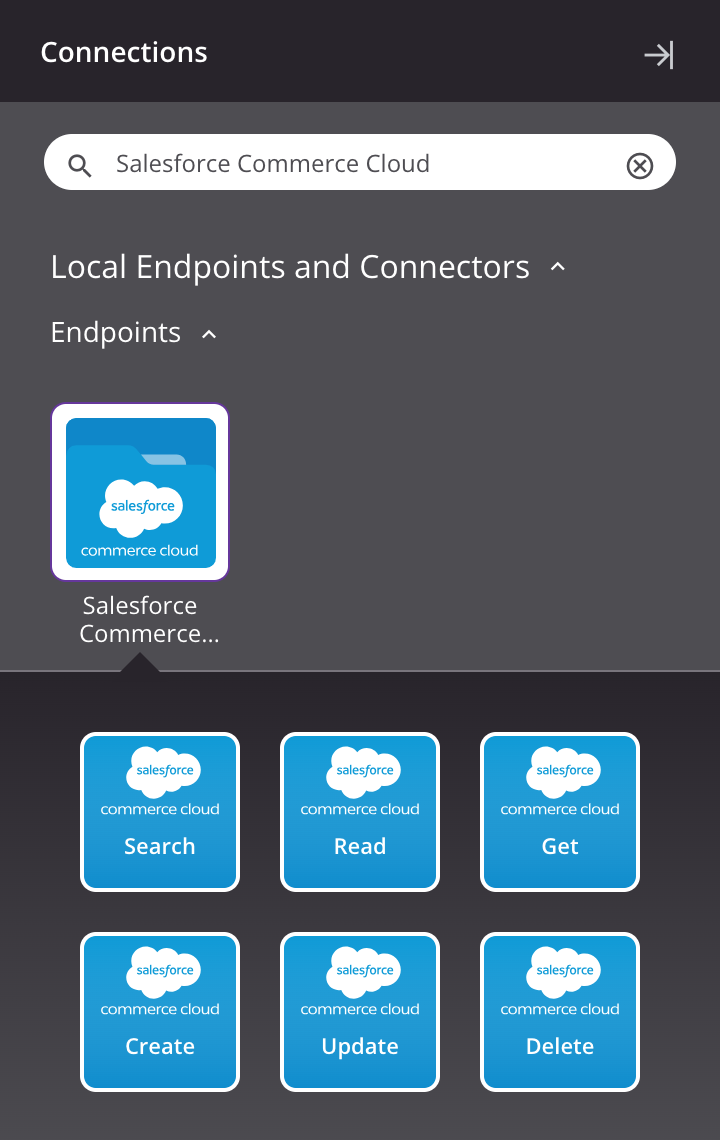Salesforce Commerce Cloud connector for Jitterbit Integration Studio
Summary
The Salesforce Commerce Cloud connector establishes access to Salesforce Commerce Cloud.
The Salesforce Commerce Cloud connector provides an interface for creating a Salesforce Commerce Cloud connection, the foundation used for generating instances of Salesforce Commerce Cloud activities. These activities, once configured, interact with Salesforce Commerce Cloud through the connection.
The Salesforce Commerce Cloud connector is accessed from the design component palette's Project endpoints and connectors tab (see Design component palette).
Connector overview
This connector is used to first configure a Salesforce Commerce Cloud connection. Activity types associated with that connection are then used to create instances of activities that are intended to be used as sources (to provide data in an operation) or targets (to consume data in an operation).
Together, a specific Salesforce Commerce Cloud connection and its activities are referred to as a Salesforce Commerce Cloud endpoint:

-
Search: Based on a specified custom query, retrieves a limited set of
Customer,Pricing, orProductobject data from Salesforce Commerce Cloud, and is intended to be used as a source in an operation. -
Read: Based on a specified set of criteria, retrieves all
Checkout,Customer, orProductobject data from Salesforce Commerce Cloud, and is intended to be used as a source in an operation. -
Get: Based on specified IDs, retrieves all
Checkout,Customer,Pricing, orProductobject data from Salesforce Commerce Cloud and is intended to be used as a source in an operation. -
Create: Creates
Customer,Pricing, orProductobject data in Salesforce Commerce Cloud and is intended to be used as a target in an operation. -
Update: Updates
Customer,Pricing, orProductobject data in Salesforce Commerce Cloud and is intended to be used as a target in an operation. -
Delete: Deletes or cancels
Customer,Pricing, orProductobject data in Salesforce Commerce Cloud and is intended to be used as a target in an operation.
Note
This connector is a Connector SDK-based connector, which may be referred to by Jitterbit when communicating changes made to connectors built with the Connector SDK.
Prerequisites and supported API versions
The Salesforce Commerce Cloud connector requires the use of an agent version 10.1 or later. These agent versions automatically download the latest version of the connector when required.
The Salesforce Commerce Cloud connector uses the B2C Commerce API. To interact with it, you need to create an API client for either Admin APIs or Shopper APIs, depending on your needs. Refer to the API documentation for information on the schema nodes and fields.
The minimum required authorization scope is sfcc.products.rw.
Limitations
This connector supports the standard objects provided by the B2C Commerce Shopper APIs and Admin APIs. It does not support custom APIs.
Troubleshooting
If you experience issues with the Salesforce Commerce Cloud connector, these troubleshooting steps are recommended:
-
Click the Test button in the connection configuration to ensure the connection is successful and to ensure the latest version of the connector is downloaded to the agent (unless using the Disable Auto Connector Update organization policy). If the test fails, make sure your credentials have a minimum authorization scope of
sfcc.products.rw. -
Check the operation logs for any information written during execution of the operation.
-
Enable operation debug logging (for cloud agents or for private agents) to generate additional log files and data.
-
If using private agents, you can enable connector verbose logging for this connector using this specific configuration entry of logger name and level:
<logger name="org.jitterbit.connector.commercecloud" level="DEBUG"/> -
If using private agents, you can check the agent logs for more information.
-
For additional troubleshooting considerations, see Operation troubleshooting.